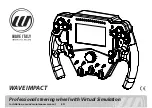
2 5 Sensor Installation Guidelines
2 5 Sensor Installation Guidelines
Proper sensor installation can eliminate many problems in a control system. The
probe should be placed so that it can detect any temperature change with
minimal thermal lag. In a process that requires fairly constant heat output, the
probe should be placed closed to the heater. In a process where the heat
d e m a n d i s v a r i a b l e , t h e p r o b e s h o u l d b e c l o s e d t o t h e w o r k a r e a . S o m e
experiments with probe location are often required to find this optimum position.
In a liquid process, addition of a stirrer will help to eliminate thermal lag. Since
the thermocouple is basically a point measuring device, placing more than one
thermocouple in parallel can provide an average temperature readout and
produce better results in most air heated processes.
P r o p e r s e n s o r t y p e i s a l s o a v e r y i m p o r t a n t f a c t o r t o o b t a i n p r e c i s e
measurements. The sensor must have the correct temperature range to meet
the process requirements. In special processes the sensor might need to have
different requirements such as leak-proof, anti-vibration, antiseptic, etc.
Standard sensor limits of error are
4degrees F (
2degrees C ) or 0.75% of
sensed temperature (half that for special ) plus drift caused by improper
protection or an over-temperature occurrence. This error is far greater than
controller error and cannot be corrected on the sensor except by proper
selection and replacement.
A
A
Proper sensor installation can eliminate many problems in a control system. The
probe should be placed so that it can detect any temperature change with
minimal thermal lag. In a process that requires fairly constant heat output, the
probe should be placed closed to the heater. In a process where the heat
d e m a n d i s v a r i a b l e , t h e p r o b e s h o u l d b e c l o s e d t o t h e w o r k a r e a . S o m e
experiments with probe location are often required to find this optimum position.
In a liquid process, addition of a stirrer will help to eliminate thermal lag. Since
the thermocouple is basically a point measuring device, placing more than one
thermocouple in parallel can provide an average temperature readout and
produce better results in most air heated processes.
P r o p e r s e n s o r t y p e i s a l s o a v e r y i m p o r t a n t f a c t o r t o o b t a i n p r e c i s e
measurements. The sensor must have the correct temperature range to meet
the process requirements. In special processes the sensor might need to have
different requirements such as leak-proof, anti-vibration, antiseptic, etc.
Standard sensor limits of error are
4degrees F (
2degrees C ) or 0.75% of
sensed temperature (half that for special ) plus drift caused by improper
protection or an over-temperature occurrence. This error is far greater than
controller error and cannot be corrected on the sensor except by proper
selection and replacement.
A
A
24
UM25001C
















































